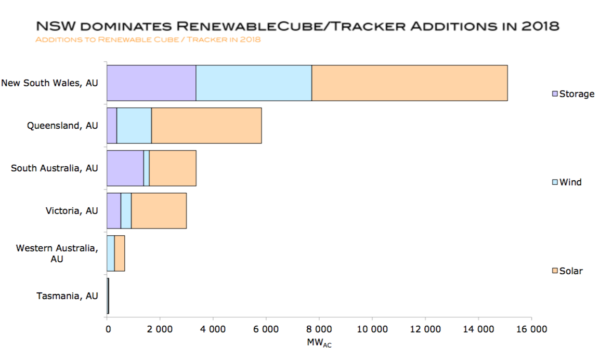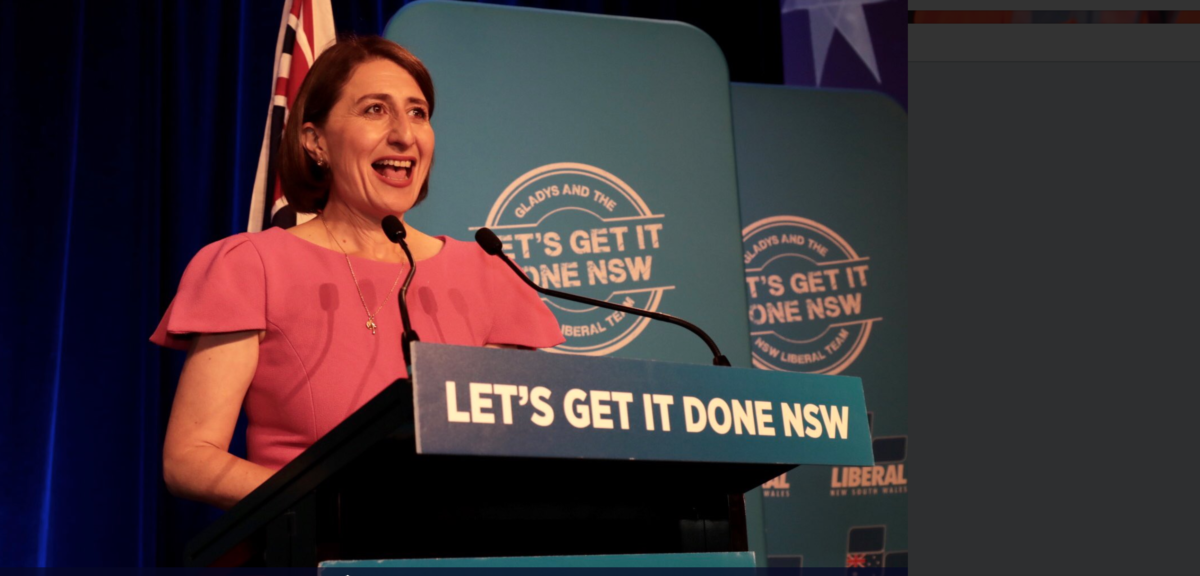Prior to the NSW election on March 23, the State Labor and Liberal Nationals Coalition parties each danced on the rooftops, rolling out support for NSW constituents to install solar with or without battery backup, and thereby mitigate the financial pain of their energy bills. Labor went much further, promising to target 50% renewable energy generation in the state by 2030, alongside what the Smart Energy Council described as “the biggest proposed rollout of renewable energy in Australian history”.
Even with no firm transition plan in sight, renewable energy developers had already by the end of 2018 proposed some 16 GW of solar, wind and battery installations for NSW, according to analyst Rystad Energy’s Australian RenewableCube. Some of those are now underway, but many are in the making and are running ahead of any plans to upgrade the state’s transmission grid which is poorly placed to collect on the renewables bonanza.

Graph: Rystad Energy
“Transmission infrastructure is just not adequate to support lots of projects coming into certain geographic areas,” says John Grimes, Chief Executive of the Smart Energy Council, which had worked hard to lobby both parties to show leadership on climate change and present clear energy-transition policies to industry and voters.
“For NSW,” he says, “identifying priority transmission zones that are well-suited to a number of projects coming online, and quantifying the amount of renewable energy development appropriate for that area would enable better co-ordination and efficiency of incoming projects.”
As it is, the pre-election Berejiklian offerings included $20 million in additional funding to the $55 million Emerging Energy Program established in 2018, which the LNP at the time said was designed to “encourage large-scale projects to provide electricity on-demand and … promote the diversification of electricity supply, via emerging technologies and renewable sources.”
Without co-ordination and planning, such projects, whether assisted by the Emerging Energy Program or not, may have nowhere to go; or they’ll provide less benefit to the state than they should, or at the very least experience ongoing difficulties in connecting to the grid as it forks up Australia’s east coast.
“The urgency is upon us!”
In its National Transmission Network Development Plan (NTNDP), released in December 2018, the Australian Energy Market Operator (AEMO) identified “an emerging reliability shortfall” for NSW.
For a start, as a result of the planned closure of the ageing Liddell Power Station in 2022, and subsequent closures of Bayswater, Vales Point and Eraring facilities within 10 years, NSW will be 9 GW lower on energy — an impending vacuum that is being and can continue to be filled with clean energy. But, says AEMO in its NTNDP, “It will be crucial that the interconnector upgrades from Queensland and Victoria are delivered in a timely manner, and that new local firm generating capacity is developed prior to the Liddell Power Station closure.”
AEMO continues, “Prudent investment is also needed in the network to connect renewable resources within New South Wales, or the shortfalls could be larger.”
As Shadow Minister for Energy and Climate Change, Adam Searle, told pv magazine prior to the election, “The urgency is upon us.”
State Labor in opposition had a plan to bring 7 GW of large-scale renewables into the NSW energy landscape within 10 years, and recognised the need to support upgrades to the transmission system.
Searle said, “NSW Labor supports in principle, the Integrated System Plan developed by AEMO. We know that strategic investment in transmission upgrades can unlock value in new investment, but will also mean we have to spend less money investing in new energy generation projects. So we’re committed to that.”
“We can’t wait a decade to enable renewables.”
Grimes emphasised to pv magazine today, the importance of the newly formed NSW government prioritising the upgrade of NSW energy infrastructure. “We can’t wait a decade to enable renewables.”
A strong and future-focused state policy, such as a renewable energy target, says Grimes, provides the framework that allows government to “pull other levers that are not necessarily about funding, but about practical measures” that support planning essential to clear the way for new projects to be approved, built and connected. Lack of commitment to energy transition by the State Liberals over the past two terms, he says has resulted in inefficiency at best.
The track record of the Liberal government in NSW over the past few years does not inspire confidence. Taking rooftop solar adoption as a barometer the environment it has created for transition, NSW shows 18% penetration compared to national frontrunners South Australia and Queensland, which can each boast in excess of 32%.
Grimes looks forward to bringing Smart Energy Council expertise to implementation of the new government’s Empowering Homes promise, which provides interest-free 10-year loans of up to $9,000 for a battery system, and $14,000 for a solar-plus-battery system.
“This is a good initiative,” he says, “and we’d like to work very closely with the NSW Government to make it as successful as possible.”
Up to 300,000 households across NSW could save hundreds of dollars a year on their power bills with no-interest loans to purchase solar-battery and battery systems. The NSW Government is working hard to ease the cost of living for families right across the state. @Dom_Perrottet pic.twitter.com/dhavSJ15Wq
— Gladys Berejiklian (@GladysB) February 10, 2019
Every other state and territory, bar Western Australia, has a renewable energy target of at least 50% by 2030. “To be in a position for the next four years in which NSW doesn’t have a climate-change policy is untenable,” says Grimes, especially given that, “The next decade will be critical for an accelerated response to the accelerating effects of climate change.”
On Monday, senior Liberal sources told the Sydney Morning Herald that the majority conferred on Berejiklian’s party by the election would make the Premier “much more assertive”, both in choosing her new cabinet and her priorities.
Environment and sustainability were purported to be high on her list. Could these, in Liberal parlance, be code for energy transition? The people of NSW can’t afford to guess, says Grimes, who urges voters not to be complacent in their Federal Election choices.
This content is protected by copyright and may not be reused. If you want to cooperate with us and would like to reuse some of our content, please contact: editors@pv-magazine.com.









2 comments
By submitting this form you agree to pv magazine using your data for the purposes of publishing your comment.
Your personal data will only be disclosed or otherwise transmitted to third parties for the purposes of spam filtering or if this is necessary for technical maintenance of the website. Any other transfer to third parties will not take place unless this is justified on the basis of applicable data protection regulations or if pv magazine is legally obliged to do so.
You may revoke this consent at any time with effect for the future, in which case your personal data will be deleted immediately. Otherwise, your data will be deleted if pv magazine has processed your request or the purpose of data storage is fulfilled.
Further information on data privacy can be found in our Data Protection Policy.